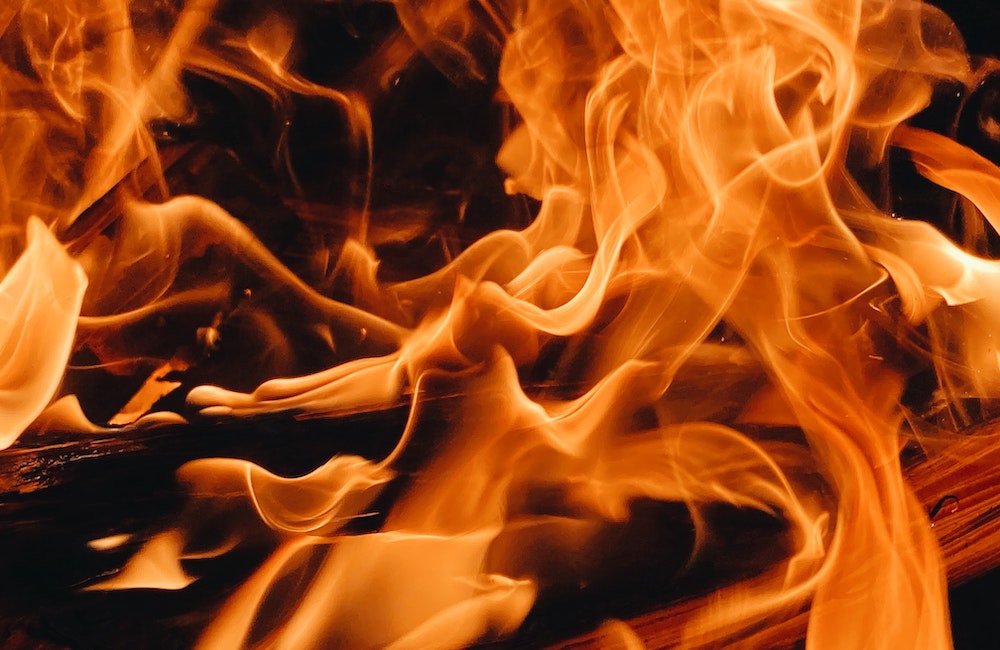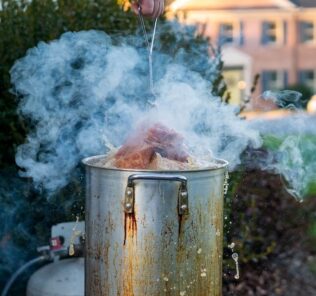Dangers of Cooking with Oil on Thanksgiving Demonstrated by Simulated Turkey Fires
Cooking fires in residential buildings occurred more often on Thanksgiving Day than any other day of the year due to the oil-based cooking of the traditional turkey. According to FEMA, for each year from 2017 to 2019, an estimated average of 2,300 residential building fires were reported to fire departments in the U.S. on Thanksgiving Day. For this reason, HealthySimulation.com dedicates one article per year as a Public Service Announcement focused on the dangers of cooking with oil in the home. Included in this PSA is a number of simulated turkey fire demonstrations, often conducted by fire departments to demonstrate just how dangerous this method of cooking can be. Remember — oil and water DO NOT MIX!
Those who are cooking for the holiday must also understand that they cannot put out an oil-based fire with water, all it will do is spread the oil and flames around. Yet, in case of an unforeseen emergency, these videos and text help explain what to do. Just as healthcare simulation is used to train professionals and providers on the risks associated with medical error, the methodology can similarly be utilized to demonstrate potential dangers associated with fires, for both firefighters and civilians.
Understanding these risks, how to avoid them and the procedures capable of mitigating them are important to ensure a safe holiday. Enjoy Thanksgiving responsibly by sharing this important Public Service Announcement (PSA). HealthySimulation.com wishes all simulationists, simulation educators, and learners a happy Thanksgiving!
Sponsored Content:
Boise Fire Department Turkey Fryer Safety Tips: The Boise Fire Department, NFPA, and Underwriters Laboratories discourage the use of gas-fueled turkey fryers that immerse the turkey in hot oil. These turkey fryers use a substantial quantity of cooking oil at high temperatures, and units currently available for home use pose a significant danger that hot oil will be released at some point during the cooking process. The use of turkey fryers by consumers can lead to devastating burns, other injuries, and the destruction of property. This video provides several tips to increase safety measures while frying a turkey.
National Fire Protection Association “Dangers of Turkey Fryers”: Turkey fryers can be dangerous and cause a serious fire hazard. NFPA and the US Consumer Product Safety Commission (CPSC) demonstrate the risk of using turkey fryers to cook a turkey. Almost instantly, flames burst from a turkey fryer and caused the deck and roof of the structure to catch fire. NFPA strongly discourages the use of turkey fryers. Home cooking fires peak on Thanksgiving, and turkey fryers can lead to severe injuries and significant property damage. This video demonstrates the dangers of turkey frying errors.
U.S. Consumer Product Safety Commission Turkey Fryer Fire: Since 2002, there have been more than 168 turkey-fryer-related fire, burn, explosion, or CO poisoning incidents, including 672 injuries and $8 million in property damage. This video demonstrates the danger and damage that can be caused by incorrectly frying a turkey.
Here are several other turkey fire simulator videos from across the United States:
Sponsored Content:
NFPA Safety Tips
Included in these safety tips, the NFPA recommends that people stay in the kitchen when they are cooking on the stovetop so that they can keep an eye on the food. The organization also recommends that those preparing meals should stay at home when cooking the turkey, and check on the process frequently. Be sure that smoke alarms are working, and test them by pushing the test button. The following are tips and recommendations from NFPA for cooking safely this Thanksgiving:
- Never leave the kitchen while cooking on the stovetop. Some types of cooking, especially those that involve frying or sautéing with oil, need continuous attention.
- When cooking a turkey, stay in your home and check on it regularly.
- Make use of timers to keep track of cooking times, particularly for foods that require longer cook times.
- Keep things that can catch fire like oven mitts, wooden utensils, food wrappers, and towels at least three feet away from the cooking area.
- Avoid long sleeves and hanging fabrics that could come in contact with a heat source.
- Always cook with a lid beside your pan. If you have a fire, slide the lid over the pan and turn off the burner. Do not remove the cover because the fire could start again. Let the pan cool for a long time. Never throw water or use a fire extinguisher on the fire.
- For an oven fire, turn off the heat and keep the door closed. Only open the door once you’re confident the fire is completely out, standing to the side as you do. If you have any doubts or concerns, contact the fire department for assistance.
- Keep children at least three feet away from the stove. Kids should also stay away from hot foods and liquids, as steam or splash from these items could cause severe burns.
If children are nearby when the meal is being prepared, people should make sure electric cords from an electric knife, coffee maker, plate warmer or mixer are not dangling off the counter within easy reach. Other best practices include keeping matches, utility lighters, knives, hot foods, and liquids out of children’s reach. The steam or splash from vegetables, gravy, or coffee can cause serious burns as well. Ultimately, children should be kept three feet away from the stove and away from any lit candles.
Subscribe to Our Newsletter for More Great Simulation Content!
Lance Baily, BA, EMT-B, is the Founder & CEO of HealthySimulation.com, which he started while serving as the Director of the Nevada System of Higher Education’s Clinical Simulation Center of Las Vegas back in 2010. Lance is also the Founder and acting Advisor to the Board of SimGHOSTS.org, the world’s only non-profit organization dedicated to supporting professionals operating healthcare simulation technologies. His co-edited Book: “Comprehensive Healthcare Simulation: Operations, Technology, and Innovative Practice” is cited as a key source for professional certification in the industry. Lance’s background also includes serving as a Simulation Technology Specialist for the LA Community College District, EMS fire fighting, Hollywood movie production, rescue diving, and global travel. He and his wife Abigail Baily, PhD live in Las Vegas, Nevada with their two amazing daughters.
Sponsored Content:
















